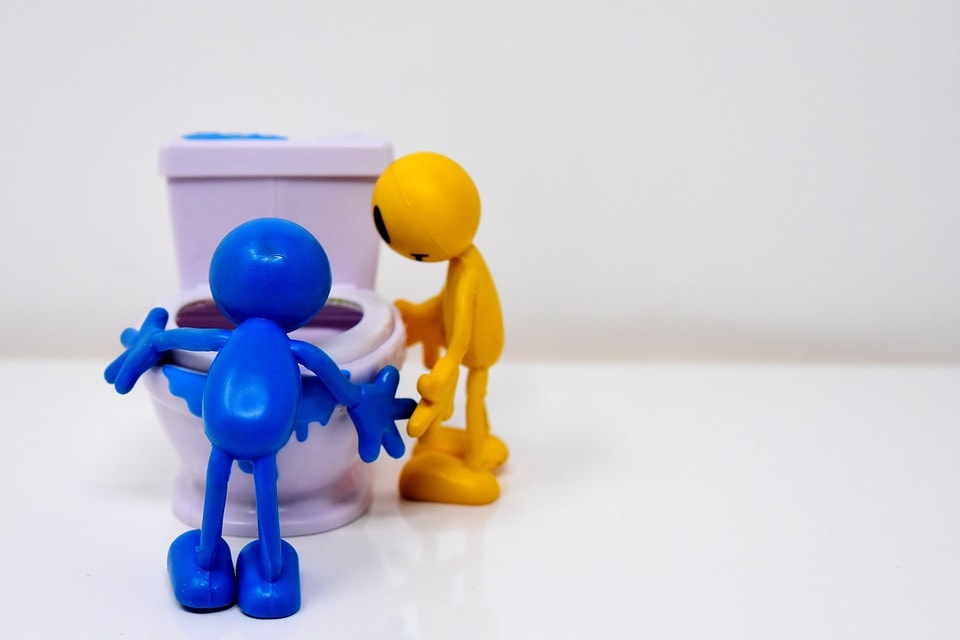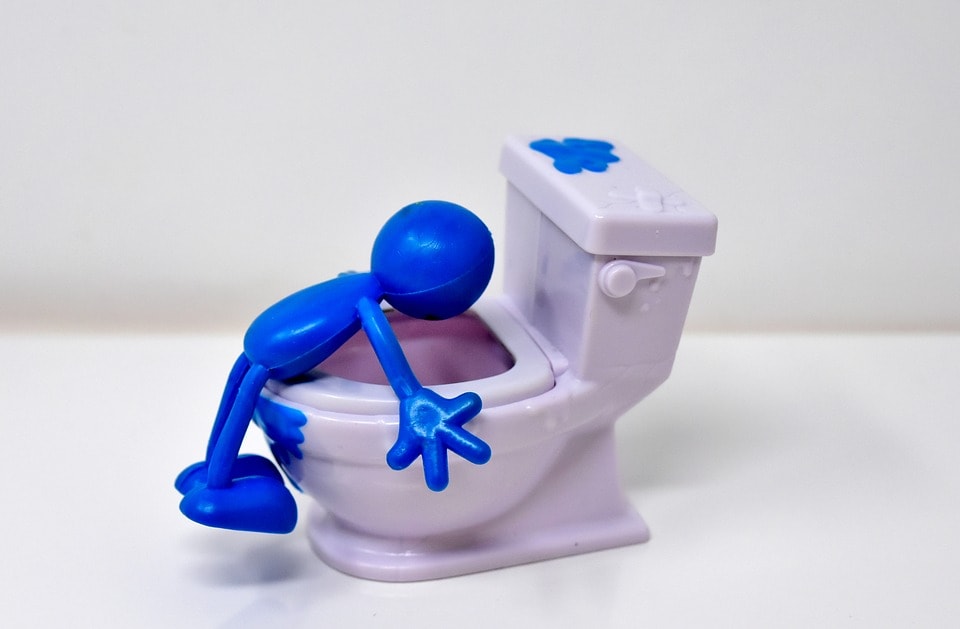The average person uses about 80-100 gallons of water a day and 30 percent of that is from flushing the toilet. As a matter of fact, toilets contribute more to your daily water usage than anything else in the home.
You can use this online form to calculate your estimated water use.
With the average US household having almost 3 people in it this can add up to 300 gallons a day or more for your house.
Imagine how much water you can save with some best practices? Let’s talk about the unsung hero of home water conservation, the toilet.
Recommended Read: The Best Toilet Seat Ever
In This Article We'll Discuss
Table of Contents
How much water do toilets use?
How much water is used when you flush the toilet is going to be determined by when the toilet was made. Recent advancements have lowered the average to 1.28 gallons per flush. The federal standard is at 1.6 gallons per flush. Much of recent water conservation efforts are because of improved toilet flushing technologies. Hooray planet and hooray savings! (less was per flush = less water used = lower water bill) If you have a toilet made before 1992 you can use up to 5 to 8 gallons per flush! If you do have an older toilet it will benefit your wallet to update to a modern option.
Recommended Read: The Best Toilet Brush to Clean Easy and Quickly
Toilet Water Saving Tips
A person averages around five toilet flushes per day. (These are at home flush or not considering flushes as work or school). Considering an average of 1.28 gallons per flush thats 6.4 gallons per day. Now considering that the average home has 2.6 people per household that’s 16.64 gallons of water per household. That’s a lot of water. So why is this important? Your water bill. Oh, and the planet. Here are some tips to help save with your toilet, the highest user of water in your home.1. Using Less Water Per Toilet Flush A toilet fill cycle diverter helps save some money by diverting water. It will divert water from the toilet bowl to the tank. The tank will fill quicker and with less water in the bowl. You’ll save about a ½ gallon per bowl. For the average american household that is 2,373 less gallons of water per year. There are variations of this device and some go up to .8 less gallons of water per flush. A plastic bottle filled with water placed in the toilet tank is another way to achieve this. You probably have one lying around and won’t have to go out shopping or order online. Recommended Read: The Best Bidet Toilet Seats to Save Money 2. Don’t Flush… As Much! To be honest, not flushing as much is not for everyone. But, this will save you more water than the first method so if you are serious about saving water consider it. The old quote “if it’s yellow, let it mellow” fits quite nicely here. What this means is that you only flush after solid waste is “produced” To help with this keep the toilet seat down to keep any odors at bay. You can also flush every other time number 1 takes place. The slightest adherence to this strategy will help reduce water usage. It’s a good idea to not practice this will you have guests over(if you care what they think). Reducing your families flushes from from 13 to 7 or so will save about 8 gallons a day or more. That’s 2803 less gallons per year! 3. Buckets In The Shower What do you do when you’re getting ready to shower. Most likely you let the water run to let it warm up. This is more precious water that is being wasted and going down the drain. What can you do with this water? Put a bucket in the shower and let the water collect. Why? To use it to flush your toilet. To do this just throw the bucket into the tank when you need to go. Now you’re saving wasted water in the shower and saving a wasted flush! Recommended Read: Water Saving Dual Flush Toilets 4. Is Your Toilet Up To Date? Upgrading a toilet is probably the lowest on your home to do list. If your toilet is 10 or 15 years old, it might be a good idea considering how much what it’s wasting. It’ll pay for itself in savings over a few years/Some municipalities will give you a tax rebate if you upgrade an older toilet. It has to be something more efficient. Check your local state and county websites. Here’s an example of one in Florida Look for toilets with the watersense certificate. These are the most efficient water toilets. Keep an eye out when you are shopping.
Recommended Read: Stylish Space Saving Small Toilets
Old vs New Toilets Water Usage
Old Toilets
What is an old toilet? Anything manufactured before 1992. If your toilet is from before 1980 it falls to a worse category.
So what is the problem with older toilets? Well, before 1992 they used an average of 3.5 gallons per flush (triple todays amount).
If it was made before 1980 it can use as much as 7 gallons per flush (5.5 times more than today, yikes!).
Since porcelain can last over half a century you may have an old toilet in your home. Sometimes the pipes switched out and the toilet isn’t remove. If the toilet is still function and looks fine some opt to leave it in during a remodel.
New Toilets
New toilets come in a few flush and efficiency acronyms. Uou should familiarize yourself with them before shopping. Recommended Read: The Best Toilet Repair Kit Ultra Low Flush Toilets (ULF) These toilets will flush a max of 1.6 gallon per flux. This is also what the federal law requires. ULF toilets are not more expensive and start at about $100 so you don’t have to worry about it being a costly investment. High Efficiency Toilets (HET) HET toilets are more efficient than the ULFs by flushing at a max of 1.3 gallons per flush. These toilets are used in new homes and began seeing using in the 1990s. Dual-Flush Toilets These toilets come with two different flush settings (if you didn’t guess it by the name). There’s an option for a half flush and one for a full flush. Full flush are reserved for flushes with solid waste and half flushes for number 1. Recommended Read: Best Toilet Auger to Get Rid of Any Clog
Checking the water usage of your toilet
So now you know all about saving water with your toilet and the different types of toilets but you’re not sure how much your current toilet is using. Let’s solve this! This first method would be to check the labeling on your toilet. They are typically displayed just above the lid near the seat hinge. If it’s not there check under the side of the tank lid and inside the tank. If it doesn’t display its water usage then check for the date it was stamped. This is typically stamped on the porcelain.
Recommended Read: The Best Efficient Toilet Fill Valves
- 1980 or older can be 7 gallons per flush
- 1980-1994 can be 3-5 gallons per flush
- 1994-Today can be 1.6 gallons or less
If none of these methods work for you then you will have to manually test for water consumption.
Before using any of these methods make sure no water saving device has been placed in your tank. This can be a water bottle filled with water or a plastic bag(some toilet flapper kits are designed to save water as well).
Recommended Read: The Best Toilets By Kohler
Testing Toilet Flush Water Usage

Toilet Tank Capacity Method
Step 1
Turn off the water supply. Be cautious of old valves as they may leak water.
Step 2
Remove the tank lid. Some tanks will already have a marked factory reset line showing where the line should fill to. If it doesn’t just mark where the water is yourself with a pencil or pen.
Step 3
Flush the toilet.
Step 4
Use a container with a measurable amount of water (a gallon container works best). Note how many gallons of water to refill the tank.
Step 5
Add a half gallon to how many gallons it took to fill to the fill line.
This is how many gallons of water your toilet uses per flush.
Recommended Read: The Best One Piece Toilets
Water Meter Method
This method only works for properties that are individually water metered.
Step 1
Make sure no water is being used anywhere in your home. Locate you water. Most water meters are in front of the property by the curb or in the basement. They’re sometimes covered by a box so remove the lid.
Note the location or current measurement of water usage.
Step 2
Go inside and flush the toilet one time. Go back outside and read how far the meter’s dial has moved. If it uses an arm each full rotation is 7.5 gallons of water.
Step 3
Repeat steps 1 and 2 and get a second measurement. Find the average between the two and this will be how much water your toilet uses per flush.
How the toilet became a water Conservation Hero
Since the toilet is the highest user of water in an American home it leads in water conservation. Who knew the humble toilet could be a hero? About 24-30% of home water usage is flushing toilet water. Since 1999 houses have decreased water usage by 22% and we have the humble toilet to thank for that. Carrying the largest weight, new technologies and efficiencies were developed to conserve water. A big push for that was the water conservation act placed in the United States in 1992. It became mandatory in 1994. Since then all new toilets could only use 1.6 gallons of water per flush (3-5 gallons or more was common during this time). What’s great about this is that no behavior change is needed to conserve water. It is as simple as updating your toilet and proceeding as normal.
Recommended Read: The Most Comfortable Toilet Seat
Next Steps In Saving Water In Your Home
Now that you’ve determined how much water your toilet is using your ready to put in place new water flush saving techniques. You’re ready to save water and money!
The environment and your wallet will thank you (isn’t this the best situation?).
It may seem this article was preparing you more to stop a dam than conserve water, saving water is a good thing. Imagine how many gallons can be saved if we all implemented one of these options?




I found it beneficial when you said that high-efficiency toilets flush at 1.3 gallons per flush. My wife is wanting to install a high-efficiency toilet in our bathroom as part of the renovations this summer. We’ll have to find a good toilet to save on water and energy.